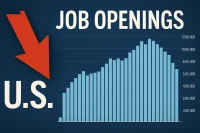In a surprise move, the US Department of Defense has awarded Boeing a multi-billion-dollar contract to develop the Air Force’s next-generation fighter jet, the F-47
deal, potentially worth over $50 billion, is now the most expensive jet-fighter program in US history.
For Boeing, this is more than a defense win—it’s a vital lifeline.
The company has suffered from repeated crises, including safety issues with its 737 MAX, a delayed Air Force One program, and six consecutive years of financial losses.
With no major military or commercial aircraft successfully launched in over a decade, the F-47 program offers a long-overdue reset.

Why Boeing Beat Lockheed Martin
Boeing’s selection surprised analysts who expected Lockheed Martin, maker of the F-35, to win.
But Lockheed’s F-35 has been plagued by cost overruns, delays, and persistent technical problems.
Boeing, meanwhile, backed its F-47 proposal with a $2 billion expansion of its St. Louis facility and years of experimental test flights.
The F-47 will replace the F-22 and is designed to handle emerging threats with cutting-edge capabilities, including semi-autonomous drone coordination, stealth technology, and long-range strikepotential.
Boeing’s pitch was reinforced by its willingness to move away from risky fixed-price contracts.
This time, the development phase is covered under a cost-plus agreement—meaning the Pentagon will reimburse Boeing’s expenses and pay a guaranteed fee. It’s a financial structure Boeing badly needed.
What the F-47 Means for Jobs
Skilled Labor in High Demand
Boeing’s F-47 program is expected to generate thousands of jobs, especially at its expanded Missouri production site.
Demand will surge across key roles, including aerospace engineers, software developers, systems architects, and defense manufacturing specialists.
Ron Epstein of Bank of America told the Wall Street Journal:
“Boeing isn’t the fighter central it once was.
“They’ll need to hire a lot of skilled engineers quickly.”
Workforce Development Opportunities
The program may also trigger new workforce development initiatives:
- Skilled trades such as welders, machinists, and avionics technicians will be critical.
- Ex-military talent with aircraft maintenance backgrounds will likely be in high demand.
- Universities and technical colleges may see new aerospace partnerships to fill long-term gaps.
Broader Economic Impact
Beyond Boeing’s walls, suppliers, subcontractors, and logistics firms across the defense ecosystem stand to benefit.
If successful, the F-47 could mark the beginning of a broader revival in US aerospace manufacturing.
Trump’s Involvement and Strategic Messaging
The aircraft’s name—F-47—appears to reference Donald Trump, now in his second term as the 47th US president.
He personally announced the deal from the Oval Office, praising the fighter’s capabilities.
He said:
“There’s never been anything even close to it.
He called it
“The most advanced, most capable, most lethal aircraft ever built.”
Chief of Staff of the Air Force Gen. David Allvin added:
“With the F-47, we are not just building another fighter – we are shaping the future of warfare and putting our enemies on notice.
This platform will be the most advanced, lethal, and adaptable fighter ever developed – designed to outpace, outmaneuver, and outmatch any adversary that dares to challenge our brave Airmen.”
While politically symbolic, the decision reflects a growing urgency within the Pentagon to maintain an edge over adversaries like China. The F-47 is expected to play a central role in future air dominance strategies.
What Employers and Job Seekers Should Watch
This deal is more than just a military contract. It signals a shift in the defense sector:
- Employers should prepare for a surge in hiring and competition for engineering talent.
- Job seekers with STEM backgrounds may find new, long-term career paths in aerospace.
- The F-47 program could drive salary growth and reskilling programs across multiple states. As Boeing moves into the execution phase, its ability to meet development targets will be closely watched—not just by the military, but by the job market as well. The stakes couldn’t be higher: the F-47 may determine whether Boeing’s future takes flight or stays grounded.




